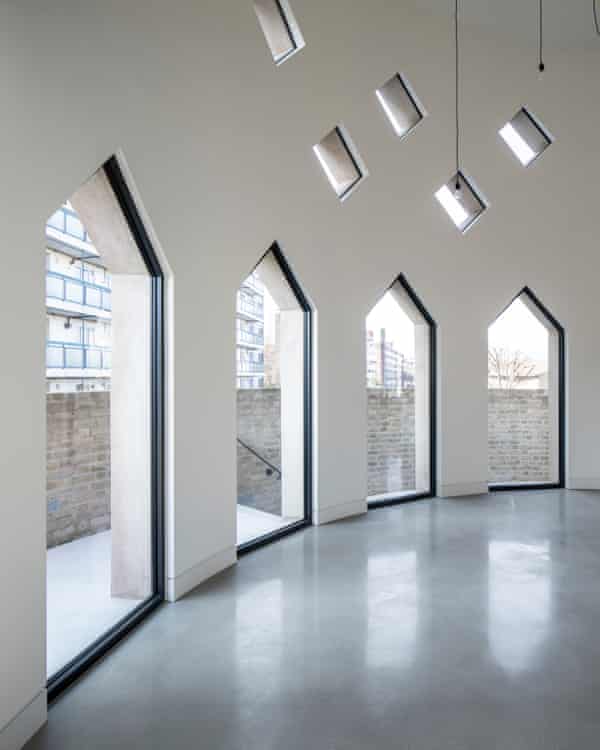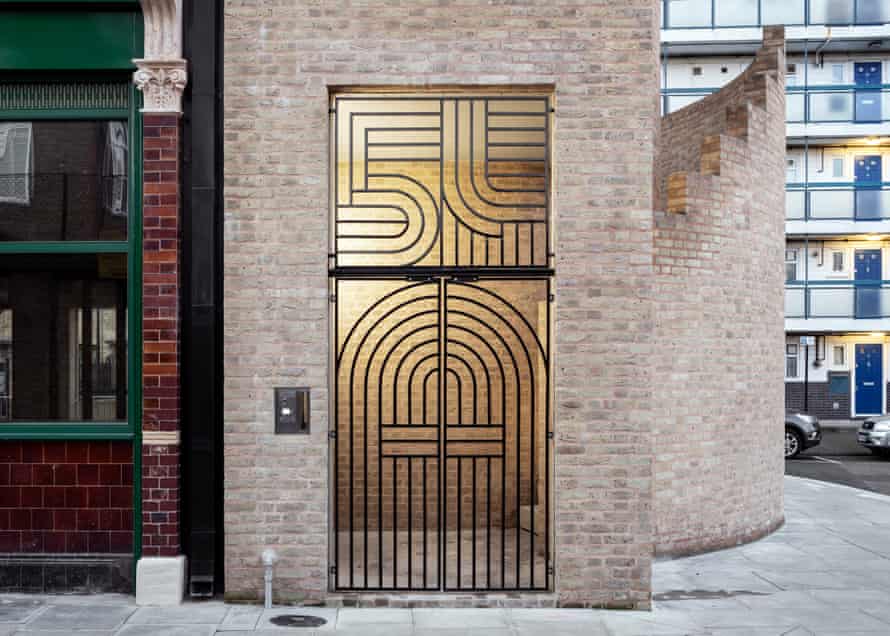The Ivy Street Family Centre is a small charity in Hoxton, east London, that provides a playschool – an “oasis of warmth and fun”, the website says – for local under-fives. Konstantin Melnikov (1890-1974) was a radical architect of early revolutionary Russia who built an astonishing house for himself in Moscow. The two wouldn’t have much in common, had they not been brought together by a punchy, romantic, multifaceted, cross-bred building that contains more ideas than others 50 times as big.
This is 54 Ivy Street, by the architect Sam Jacob. It is both a house, originally intended for Jacob’s own use, and enlarged and enhanced premises for the playgroup. It’s a new building, a rounded brick structure, and an old one, retaining a fragment of a former pub where the charity started out in 1981. The building’s appeal is direct – childlike, you might say – a castle, a ship, a thing you can clamber over, with geometric openings through which a giant toddler might push matching shapes. It is also erudite, dense with architectural allusion.
Its setting is made up of fragments and accidents. What would once have been made of tight-knit brick streets of a type familiar to British cities, interrupted by the more spacious and high-minded proportions of a neighbouring Victorian school, has been interrupted some more by wartime bombing and postwar planning, leaving inexplicable voids and mismatches. There are backs of houses, overabundant car parking, and an eight-storey slab of council flats, striated with concrete balconies – part of the Shakespeare-themed Arden Estate – cheerfully called Macbeth House.

Over time, much of the old Ivy Street disappeared, leaving a fragment of terrace with the pub at its end. An unknown official then drew a curved line on a plan, denoting the boundary of an empty site next to it. This oddity caught the eye of Jacob, who saw an opportunity to build himself a house, while also upgrading the playgroup facilities. He was formerly one of the triumvirate who until 2014 ran the iconoclastic practice FAT, authors of the BBC’s studios at Roath Lock in Cardiff and (with Grayson Perry) A House for Essex, and wanted to show what he could do in his own name. So he started to work out a deal with the family centre.
Seven years later, it being quite difficult to bring off this relationship, the project is completed. The playschool occupies the ground floor and basement, the house the floors above. The bottom part of the structure fills the curve of the site, adding a big, bull-nosed wall to the old terrace fragment, a form that repeats at the upper levels to enclose the main part of the house, then repeats again to make a small rooftop pavilion. The design sets up a chorus of U-shapes, joined by some Os – circular openings and a rooftop cylinder – and punctuated by an exotic pattern of diamond and triangle-topped windows.
Inside the house there is an array of contrasting volumes – a double-height living room within the diamond-punctured curve; a high work platform reached by a ladder; an introspective, wood-lined work space; eventually a roof terrace for viewing the raucous London skyline – all orchestrated around a sequence of stairs that start outside, wrapping round the curve, and continue indoors. It feels like several buildings in one, joined, to use a fancy art-historical term, in a promenade architecturale.

The reference to Melnikov, whose house also features cylinders and diamond windows, is (for those in the know) clear. There are more, less striking borrowings: from the 19th-century visionary Joseph Gandy, who painted stacked-up compositions of different architectural styles, and from the sophisticated three-dimensional arrangements of the early 20th-century Viennese maestro Adolf Loos. There are bits from the 1980s projects of John Hejduk and Toyo Ito, American and Japanese respectively.
The house number, writ large in metalwork above the front door, jokingly echoes the graphics of the New York club Studio 54. The rooftop structures are inspired by the water tanks above that city’s apartment blocks. It is, in other words, an idiosyncratic encyclopedia of architectural history, to which are added local elements: Jacob’s design picks up on a high brick wall that encloses the school playground, on the ad hoc accretion to the backs of terrace houses, on the steps and decks of the council housing. To the already multifarious neighbourhood he adds layers of his own, yet brings them all back together in a single satisfying object, bound together by the sober London brick of which it is mostly made.

It’s conceivable that the references to Hejduk and Gandy may not be immediately comprehended by the young users of the playgroup, or indeed the average adult passerby. It might simultaneously be noted that the architectural fun is mainly bestowed on the residence, the playschool being given more ordinary spaces in the lower levels, although the executive director of the family centre has declared herself “thrilled” with this “wonderful facility for the community”.
But the recondite nature of the sources matters not at all; nor will the future inhabitants of the house (Jacob has chosen for now not to live there) be the only beneficiaries of his imagination. The architecture gives simple enough pleasures to the vast majority who don’t know these histories, while also offering evidence of a creative brain at work, which might at the minimum provoke some curiosity.
Melnikov suffered career-ending denunciation when his style fell from favour under Stalin. It would be an exaggeration to say that FAT experienced anything like this (and Jacob, for example, has been gainfully employed on recently completed upgrades to the entrance of the Victoria and Albert Museum), but it’s still the case that mainstream construction in Britain found them too exotic to award them much by way of skyscrapers and major museum buildings. The evidence of Ivy Street is that the FAT legacy still has much to offer the built fabric of the nation.